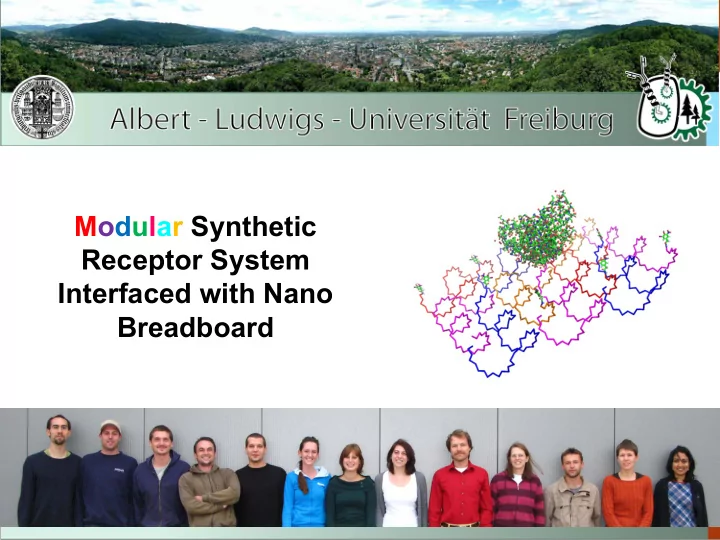

Modular Synthetic Receptor System Interfaced with Nano Breadboard
Synthetic receptor scheme
Synthetic receptor model Active state Inactive state, protein split
Principle of a construction kit FluA-Anticalin scFv-Anti-NIP Transmembraneregion Transmembraneregion EGF-Receptor B cell receptor Split β -Lactamase Split Cerulean Split Venus CFP YFP
Cloning of our construction kit Signal- Lipocalin-FluA- GGGS- Transmembrane- Split- peptide Anticalin Linker Split-Venus-cYFP region EGFR Linker Transmembrane- Antibody-anti-NIP Split-Cerulean-cCFP region BCR Split- β -Lactamase 1 Split-Luciferase 1 Submitted: 13 basic and 28 Split-Venus-nYFP composite parts in E. coli vectors. Split-Cerulean-nCFP Split- β -Lactamase 2 Further 16 parts were cloned in an eukaryotic transfection Split-Luciferase 2 vector.
Using BioBrick 3.0 EcoRI NotI XbaI NgoMIV AgeI SpeI NotI PstI | | | | | | | | GAATTCgcggccgctTCTAG Atg GCCGGCnnnnnnACCGGTtaatACTAGTagcggccgCTGCAG 1 ---------+---------+---------+---------+---------+---------+----- 65 CTTAAGcgccggcgaAGATCTacCGGCCGnnnnnnTGGCCAattaTGATCAtcgccggcGACGTC c I R G R F * M A G ? ? T G * Y * * R P L Q - NgoMIV | CCGGC..SEQUENCE.. ----- GGCCG..SEQUENCE.. G AgeI | . ..SEQUENCE..ACCGG ----- ..SEQUENCE..TGGCC T ..SEQUENCE..ACCGGC..SEQUENCE.. ------ ..SEQUENCE..TGGCCG..SEQUENCE.. T G � short flexible linker, no stop codons !!!
Expression in mammalian cells XbaI CMV- promotor PstI
Modeling: Receptor dimerization Basic receptor dimerization: Free receptor and ligand Receptor ligand binding Receptor dimerization Receptor activation Internalization
Modeling: Receptor activity Receptor activity: Model characteristics: 5 ODEs, 12 parameters
Modeling: Two distinct receptors Dimerization of two distinct synthetic receptors: � R 1 and R 1 : Dimerization, but no split protein activity � Dimerization, but no split protein activity R 2 and R 2 : � Dimerization R 1 and R 2 : � split protein activation
Modeling: Ligand dependency Protein activity dependent on ligand amount: Model characteristics: R 2 LLR 2 R 1 LLR 1 R 2 R 1 R 1 LL LL R 2 R 1 R 2 R 1 LLR 2 R 1 LL R 2 LL A 9 ODEs 25 parameters ‐ Higher activity for higher ligand concentrations until certain ligand level ‐ Decrease in activity for high amounts of ligands
Results: Programmable Input
DNA Origami DNA-Origami
DNA Origami Long (7526 nt) ssDNA Folded origami structures T ↓ 216 staple oligonucleotides 6 nm grid P. Rothemund, 2006
DNA Origami: Forcing a ssDNA in Shape by Staple Oligonucleotides M13 ssDNA, length 7526 nt This origami yields a square width: 103.7 nm , 27 turns, (288 nt) height: approx. 60 nm, 24 helices
DNA Origami
DNA Origami 5‘ linked nitro iodo phenol 3‘ linked fluorescein mid point linked Alexa 488
Results: Cellular Readout
Membrane Integration in 293T Cells YFP: cytosolic FluA-Anticalin – EGFR transmembranregion – β -Lactamase1 – YFP
Activation of Split-CFP Transfected 293T cells without stimulation Transfected 293T cells with fluorescein-oligo stimulation
β -Lactamase Activity Test (CCF4-AM) Substrate + ß-Lactamase Product Product Emission at 450 nm Substrate
Activation of Split Lactamase by Origami Negative Control: Intensity 1.0 0.8 0.6 0.4 0.2 420 440 460 480 500 520 540 Emission wavelength [nm] Sample: Intensity 1.0 0.8 0.6 0.4 0.2 420 440 460 480 500 520 540 Emission wavelength [nm]
Summary & Outlook • Devised modified DNA origami as input device • Verified DNA origami formation by AFM • Optimized buffers for origami stability and cell viability • Designed and cloned a modular synthetic receptor system • Demonstrated synthetic receptor membrane localization • Demonstrated “anticalin-split CFP receptor” activation • Demonstrated “anticalin-split lactamase receptor” activation • We showed that spatially arranged green fluorescent dyes trigger a blue fluorescent output in a human cell line. • Technology provides the foundation for universal extracellular cell programming.
Acknowledgement Instructors Dr. Kristian Müller (Biology) Dr. Katja Arndt (Biology, FRIAS, Bioss) PD Wolfgang Schamel (MPI for Immunobiology) Support & Instrumentation Janina Speck Kilian Bartholomé Dr. Christian Fleck (Physik) PD Svetlana Santer(IMTEK) Dr. Roland Nitschke (ZBSA) Prof. Ralf Baumeister (Biology, ZBSA, FRIAS) Prof. Michael Reth (Biology) Prof. Ralf Reski (Biology) Prof. Jan Korvink (IMTEK, FRIAS) Collaboration ESBS Strasbourg iGEM team
Recommend
More recommend